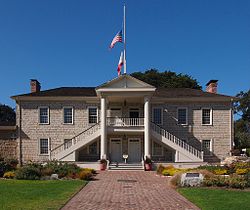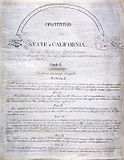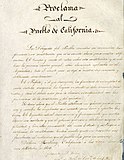Constitution of California
| Constitution of the State of California Constitución del Estado de California (Spanish) | |
|---|---|
|
Title pages of the original English (left) and Spanish (right) versions of the 1849 Constitution | |
| Overview | |
| Jurisdiction | State of California |
| Subordinate to | Supreme law of the United States |
| Created | 13 October 1849 |
| Ratified | 7 May 1879 |
| History | |
| Amendments | 514 |
| Location | California Capitol Museum, Sacramento, California |
| Author(s) | Monterey Convention of 1849 |
| Signatories | 48 delegates |
 |
|---|
The Constitution of California (Spanish: Constitución de California) is the primary organizing law for the U.S. state of California, describing the duties, powers, structures and functions of the government of California. California's constitution was drafted in both English and Spanish by American pioneers, European settlers, and Californios (Hispanics of California) and adopted at the 1849 Constitutional Convention of Monterey, following the American Conquest of California and the Mexican–American War and in advance of California's Admission to the Union in 1850.[1] The constitution was amended and ratified on 7 May 1879, following the Sacramento Convention of 1878–79.[2]
Many of the individual rights clauses in the state constitution have been construed as protecting rights even broader than the United States Bill of Rights in the Federal Constitution. An example is the case of Pruneyard Shopping Center v. Robins, in which "free speech" rights beyond those addressed by the First Amendment to the United States Constitution were found in the California Constitution by the California courts.[3] One of California's most significant prohibitions is against "cruel or unusual punishment," a stronger prohibition than the U.S. Constitution's Eighth Amendment prohibition against "cruel and unusual punishment."
The Constitution of California is among the longest in the world.[4] This is predominantly due to additions by California ballot propositions, which allow enacting amendments by a simple majority vote in a referendum. Since its enactment, the California constitution has been amended an average of five times each year.[5] As a result, if California were a sovereign state, its constitution would rank the second or third-longest in the world by total number of words.[5][6] This has led politicians and political scientists to argue the procedures for amending the California constitution are too lax, creating a state constitution that is filled with irrelevant detail and incoherent policies created by conflicting majorities attempting to impose their will on each other by the ballot process.[5]
History
[edit]
The Constitution of California has undergone numerous changes since its original drafting. It was rewritten from scratch several times before the drafting of the current 1879 constitution, which has itself been amended or revised (see below).[citation needed]
In response to widespread public disgust with the powerful railroads that controlled California's politics and economy at the start of the 20th century, Progressive Era politicians pioneered the concept of aggressively amending the state constitution by initiative in order to remedy perceived evils.[7] From 1911, the height of the U.S. Progressive Era, to 1986, the California Constitution was amended or revised over 500 times.[8]
The constitution gradually became increasingly bloated, leading to abortive efforts towards a third constitutional convention in 1897, 1914, 1919, 1930, 1934 and 1947.[9] By 1962, the constitution had grown to 75,000 words, which at that time was longer than any other state constitution but Louisiana's.[10]
That year, the electorate approved the creation of a California Constitution Revision Commission, which worked on a comprehensive revision of the constitution from 1964 to 1976. The electorate ratified the commission's revisions in 1966, 1970, 1972, and 1974, but rejected the 1968 revision, whose primary substantive effect would have been to make the state's superintendent of schools into an appointed rather than an elected official.[11] The Commission ultimately removed about 40,000 words from the constitution.[10]
Provisions
[edit]The California Constitution is one of the longest in the world.[4] The length has been attributed to a variety of factors, such as the influence of previous Mexican civil law, a lack of faith in elected officials and the fact that many initiatives take the form of a constitutional amendment.[12] Several amendments involved the authorization of the creation of state government agencies, including the State Compensation Insurance Fund, the California Department of Alcoholic Beverage Control, and the State Bar of California; the purpose of such amendments was to insulate the agencies from being attacked as an unconstitutionally broad exercise of police power or inherent judicial power.[13]
Unlike other state constitutions, the California Constitution strongly protects the corporate existence of cities and counties and grants them broad plenary home rule powers.[14] The constitution gives charter cities, in particular, supreme authority over municipal affairs, even allowing such cities' local laws to trump state law.[15] By specifically enabling cities to pay counties to perform governmental functions for them, Section 8 of Article XI resulted in the rise of the contract city.[16]
Article 4, Section 8(d) defines an "urgency statute" as one "necessary for immediate preservation of the public peace, health, or safety"; any proposed bill including such a provision includes a "statement of facts constituting the necessity" and a two-thirds majority of each house is required to also separately pass the bill's urgency section.[17]
Many of the individual rights clauses in the state constitution have been construed as protecting rights broader than the Bill of Rights in the federal constitution.[18] Two examples include (1) the Pruneyard Shopping Center v. Robins case involving an implied right to free speech in private shopping centers, and (2) the first decision in America in 1972 found that the death penalty is unconstitutional. California v. Anderson, 6 Cal. 3d 628. This noted that under California's state constitution a stronger protection applies than under the U.S. Constitution's Eighth Amendment; the former prohibits punishments that are "cruel or unusual", while the latter only prohibits punishments that are "cruel and unusual". The constitution also confers upon women equality of rights in "entering or pursuing a business, profession, vocation, or employment." This is the earliest state constitutional equal rights provision on record.[19]
Two universities are expressly mentioned in the constitution: the public state-run University of California and the private Stanford University. UC is one of only nine state-run public universities in the United States whose independence from political interference is expressly guaranteed by the state constitution.[20] Since 1900, Stanford has enjoyed the benefit of a constitutional clause shielding Stanford-owned property from taxes as long as it is used for educational purposes.[21]
Amendments and revisions
[edit]The California Constitution distinguishes between constitutional amendments and constitutional revisions, the latter of which is considered to be a "substantial change to the entire constitution, rather than ... a less extensive change in one or more of its provisions".[22] Both require passage of a California ballot proposition by the voters, but they differ in how they may be proposed. A constitutional amendment may be placed on the ballot by either a two-thirds vote in the California State Legislature or by signatures equal to 8% of the votes cast in the last gubernatorial election through the exercise of the initiative power by the voters. The signature requirement for constitutional amendments is among the lowest thresholds for similar measures of any U.S. state.[23]
As of 2023[update], this was 874,641 signatures[24] compared to a 2020 population of 39,538,223. A constitutional revision originally required a constitutional convention but today may be passed with the approval of both two-thirds of the Legislature and approval by a majority of voters; while simplified since its beginnings, the revision process is considered more politically charged and difficult to successfully pass than an amendment.[25] Voters exercising the initiative power are not permitted to propose a constitutional revision.
Signatories of the 1849 Constitution
[edit]
Many of the signatories to the state's original 1849 constitution were themselves prominent in their own right, and are listed below.[26][27][28] The list notably includes several Californios (California-born, Spanish-speaking residents).
|
|
See also
[edit]Notes
[edit]- ^ "California Secretary of State -1849 California Constitution Fact Sheet". Archived from the original on November 9, 2017. Retrieved May 1, 2018.
- ^ 1879 California constitution. Retrieved January 3, 2018.
- ^ Linda Greenhouse, "Petitioning Upheld at Shopping Malls: High Court Says States May Order Access to Back Free Speech," The New York Times, 10 June 1980, A1.
- ^ a b Janiskee, Brian; Ken Masugi (July 27, 2007). "2". Democracy in California: Politics and Government in the Golden State (2 ed.). Rowman & Littlefield Publishers, Inc. p. 27. ISBN 978-0-7425-4836-7.
- ^ a b c Gatto, Mike (June 19, 2014). "Op-Ed: It's time to declutter California's messy Constitution". Los Angeles Times. Retrieved June 25, 2024.
- ^ Center, California Constitution (June 24, 2017). "California's Constitution is Not the Longest". SCOCAblog. Retrieved June 25, 2024.
- ^ Grodin, pp. 16–17.
- ^ Grodin, p. 21.
- ^ Grodin, pp. 18–19.
- ^ a b Grodin, p. 19.
- ^ Grodin, p. 20.
- ^ Grodin 14–15.
- ^ Grodin, p. 267.
- ^ Grodin, pp. 170–92.
- ^ "Charter Cities: A Quick Summary for the Press and Researchers". cacities.org. League of California Cities.
- ^ Grodin, p. 193.
- ^ "Article 4 Legislative". California Constitution. California Legislative Counsel. Archived from the original on January 10, 1997. Retrieved September 23, 2011.
- ^ Grodin, p. 37.
- ^ Leslie W. Gladstone (August 23, 2004). "Equal Rights Amendments: State Provisions" (PDF). CRS Report for Congress. Congressional Research Service – The Library of Congress. Archived from the original (PDF) on May 17, 2014. Retrieved November 2, 2017.
- ^ Grodin, p. 156.
- ^ Grodin, p. 311.
- ^ Lee, p. 1.
- ^ Grodin, pp. 1, 3.
- ^ "How to Qualify an Initiative". Elections & Voter Information. California Secretary of State. Retrieved June 5, 2023.
- ^ Lee, p. 7.
- ^ Report of the Debates in the Convention of California on the Formation of the State Constitution (PDF). 1850. p. 498. Retrieved July 24, 2017.
- ^ "California's Constitution". JoinCalifornia. Retrieved July 24, 2017.
- ^ Wayne, R. Shepard; George R., Dorman (2020). "Profiles of the Signers of the 1849 California Constitution" (PDF). California Genealogical Society. Archived (PDF) from the original on August 19, 2023.
References
[edit]- Grodin, Joseph R.; Massey, Calvin R.; Cunningham, Richard B. (1993). The California State Constitution: A Reference Guide. Westport, Connecticut: Greenwood Press. ISBN 978-0-313-27228-8.
- Korey, John L. (2002). California Government (Third ed.). Boston, Massachusetts: Houghton Mifflin Company. ISBN 978-0-618-12284-4.
- Lee, Eugene C. (1991). "The Revision of California's Constitution" (PDF). CPS Brief. 3 (3). Archived from the original (PDF) on December 26, 2016. Retrieved September 3, 2010.
External links
[edit]- Official current text of the California Constitution
- Records of the Constitutional Convention of 1849, California State Archives
- 1849 California Constitution, full original English text, California State Archives
- 1849 California Constitution (Spanish:Constitución del Estado de California), full original Spanish text, California State Archives
- 1879 California Constitution, original unamended full text, California State Archives
- 1878–1879 Constitutional Convention Working Papers, California State Archives


